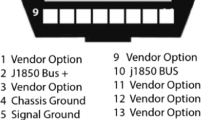Abstract
Routine and consistent data collection is required to address contemporary transportation issues. The cost of data collection increases significantly when sophisticated machines are used to collect data. Due to this constraint, State Departments of Transportation struggle to collect consistent data for analyzing and resolving transportation problems in a timely manner. Recent advancements in sensors integrated into smartphones have resulted in a more affordable method of data collection. The primary objective of this study is to develop and implement a smartphone-based application for transportation-related data collection. The app consists of three major modules: a frontend graphical user interface (GUI), a sensor module, and a backend module. While the frontend GUI enables interaction with the app, the sensor modules collect relevant data such as video, gyroscope, motion and accelerometer readings while the app is in use. The backend leverages a real-time database to stream and store data from sensors, together with providing the computational resources needed to support the application. In comparison to other developed apps for transportation data collection, this app is not overly reliant on the internet enabling the app to be used in internet-restricted areas. Additionally, the app is designed for multipurpose applications in transportation. The collected data were analyzed for a variety of purposes, including calculating the International Roughness Index (IRI), identifying pavement distresses, and understanding driver’s behaviors and environment. From the sensor data, we detected turning movements, lane changes and estimated IRI values. In addition, several pavement distresses were identified from the video data with machine learning.













Similar content being viewed by others
Data Availability
Some or all data, models, or code that support the findings of this study are available from the corresponding author upon reasonable request.
References
Aboah A, Adu-Gyamfi Y (2020). Smartphone-based pavement roughness estimation using deep learning with entity embedding. World Scientific Publishing Company 12(03n04):2050007. https://doi.org/10.1142/S2424922X20500072
Aleadelat W, Asce SM, Ksaibati K, Cameron, Wright HG, Saha P (2018) Evaluation of pavement roughness using an android-based smartphone. ascelibrary.org, Polskie Towarzystwo Stomatologiczne 144(3)
Azadi F, Adu-Gyamfi Y, Sun C, Edara P (2020) Mobile application development and testing for work zone activity real-time data collection. Transp Res Rec 2674(6):351–362
Adeli S, Najafi moghaddam Gilani V, Kashani Novin M, Motesharei E, Salehfard R (2021) Development of a relationship between pavement condition index and international roughness index in rural road network. Adv Civ Eng
Craig C, Achtemeier J, Morris N, Tian D, Patzer B (2017) In-vehicle work zone messages
Dawkin J, Bevly D, Powell B, Bishop R (2010) Investigation of pavement maintenance applications of intellidrive SM, CTS PFS Report
Dhatbale R, Chilukuri BR (2021) Deep learning techniques for vehicle trajectory extraction in mixed traffic. J Big Data Anal Transp 3(2):141–157
DOT Datazone. Accessed 05/05/2020. Available at https://datazoneapps.modot.mo.gov/aran/Home/Index?twid=3506&log=118.
Dutzik T, Madsen T, Baxandall P (2013) A new way to go: the transportation apps and vehicle-sharing tools that are giving more Americans the freedom to drive less
Efthymiou A, Barmpounakis EN, Efthymiou D, Vlahogianni EI (2019) Transportation mode detection from low-power smartphone sensors using tree-based ensembles. J Big Data Anal Transp 1(1):57–69
Flintsch GW, Valeri SM, Katicha SW, de Leon Izeppi ED, Medina-Flintsch A (2012) Probe vehicles used to measure road ride quality: Pilot demonstration. Transp Res Rec Natl Res Council 2304:158–165
GitHub link: https://github.com/ultralytics/yolov5. Accessed 4 Nov 2021
Guo F (2019) Statistical methods for naturalistic driving studies. Annu Rev Stat Appl 6:309–328
Li Q, Qiao F, Proc LY-Congress, 23rd ITS World, and 2016 (2016) Performance measures of smartphone warning messages in work zones and intersections. researchgate.net
Liao CF (2014) Development of a navigation system using smartphone and bluetooth technologies to help the visually impaired navigate work zones safely
Mandal V, Mussah AR, Adu-Gyamfi Y (2020) Deep learning frameworks for pavement distress classification: a comparative analysis. arXiv preprint arXiv:2010.10681
Miao H, Zhang S, Flannagan C (2022) Driver behavior extraction from videos in naturalistic driving datasets with 3D ConvNets. J Big Data Anal Transp 4(1):41–55
Pal M, Sutradhar R (2014) Pavement roughness prediction systems: a bump integrator approach. Int J Civ Environ Eng 8(12):1258–1261
Papadimitriou E, Tselentis DI, Yannis G (2018) Analysis of driving behaviour characteristics based on smartphone data. Proceedings of 7th Transport Research Arena TRA, 16–19
Rahman R, Fengxiang Qiao M, Li Q, Yu L (2016) Developing a smartphone based warning system application to enhance the safety at work zones
Robinson R, Cook SJ (2012) Slippery road detection and evaluation
Sauerwein PM, Smith BL, Studies U. of Virginia. C. for T. (2011) Investigation of the implementation of a probe-vehicle based pavement roughness estimation system. Virginia Transportation Research Council
Streamlit. Available at https://docs.streamlit.io/en/stable/api.html. Accessed 01 Oct 2020
Zeng H, Park H, Smith B, Engineering EP-KJ (2018) Feasibility assessment of a smartphone-based application to estimate road roughness. Springer Verlag 22(8):3120–3129
Funding
This research did not receive any specific grant from funding agencies in the public, commercial, or not-for-profit sectors.
Author information
Authors and Affiliations
Contributions
Each of the three authors made equal contribution to: conceptualization, conducting experiments, analysis of the experimental data, writing, and reviewing the manuscript.
Corresponding author
Ethics declarations
Conflict of interest
On behalf of all authors, the corresponding author states that there is no conflict of interest.
Additional information
Publisher's Note
Springer Nature remains neutral with regard to jurisdictional claims in published maps and institutional affiliations.
Rights and permissions
Springer Nature or its licensor holds exclusive rights to this article under a publishing agreement with the author(s) or other rightsholder(s); author self-archiving of the accepted manuscript version of this article is solely governed by the terms of such publishing agreement and applicable law.
About this article
Cite this article
Aboah, A., Boeding, M. & Adu-Gyamfi, Y. Mobile Sensing for Multipurpose Applications in Transportation. J. Big Data Anal. Transp. 4, 171–183 (2022). https://doi.org/10.1007/s42421-022-00061-8
Received:
Revised:
Accepted:
Published:
Issue Date:
DOI: https://doi.org/10.1007/s42421-022-00061-8




